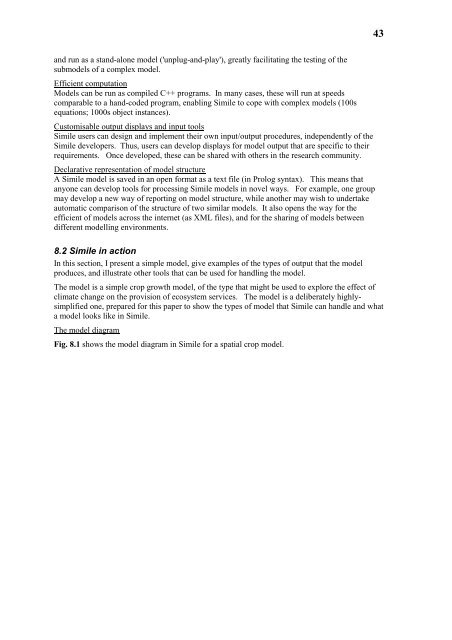pdf: 600KB - Potsdam Institute for Climate Impact Research
pdf: 600KB - Potsdam Institute for Climate Impact Research
pdf: 600KB - Potsdam Institute for Climate Impact Research
You also want an ePaper? Increase the reach of your titles
YUMPU automatically turns print PDFs into web optimized ePapers that Google loves.
43<br />
and run as a stand-alone model ('unplug-and-play'), greatly facilitating the testing of the<br />
submodels of a complex model.<br />
Efficient computation<br />
Models can be run as compiled C++ programs. In many cases, these will run at speeds<br />
comparable to a hand-coded program, enabling Simile to cope with complex models (100s<br />
equations; 1000s object instances).<br />
Customisable output displays and input tools<br />
Simile users can design and implement their own input/output procedures, independently of the<br />
Simile developers. Thus, users can develop displays <strong>for</strong> model output that are specific to their<br />
requirements. Once developed, these can be shared with others in the research community.<br />
Declarative representation of model structure<br />
A Simile model is saved in an open <strong>for</strong>mat as a text file (in Prolog syntax). This means that<br />
anyone can develop tools <strong>for</strong> processing Simile models in novel ways. For example, one group<br />
may develop a new way of reporting on model structure, while another may wish to undertake<br />
automatic comparison of the structure of two similar models. It also opens the way <strong>for</strong> the<br />
efficient of models across the internet (as XML files), and <strong>for</strong> the sharing of models between<br />
different modelling environments.<br />
8.2 Simile in action<br />
In this section, I present a simple model, give examples of the types of output that the model<br />
produces, and illustrate other tools that can be used <strong>for</strong> handling the model.<br />
The model is a simple crop growth model, of the type that might be used to explore the effect of<br />
climate change on the provision of ecosystem services. The model is a deliberately highlysimplified<br />
one, prepared <strong>for</strong> this paper to show the types of model that Simile can handle and what<br />
a model looks like in Simile.<br />
The model diagram<br />
Fig. 8.1 shows the model diagram in Simile <strong>for</strong> a spatial crop model.
















